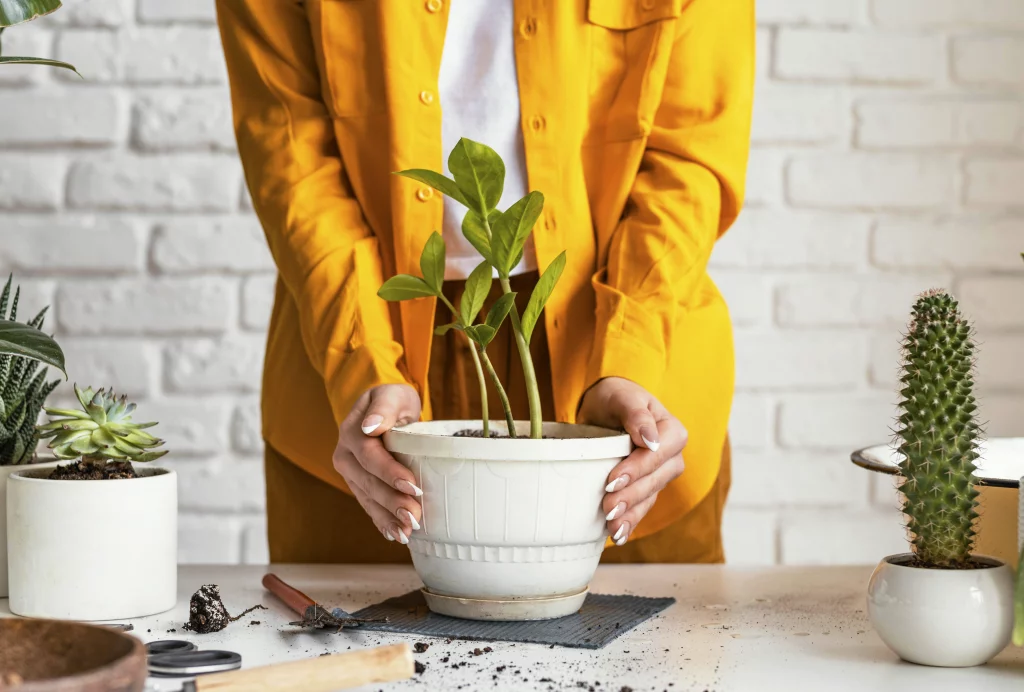
Clay and terracotta are classic materials used for plant pots. It works extremely well and does wonders to drier root systems. Pots made of terracotta have a porous surface that allows air to enter and help the plant. It also allows water to move out of the pot and helps prevent rotting of the root and plant disease.
However, clay pots require regular cleaning once in a while. Soil and water may leave stains on their surface. What is more, the pots can collect harmful bacteria. It is especially important to clean the pot once you remove an old plant and are about to place another one in the pot. If you don’t take enough time cleaning the residue, the bacteria will affect the new plant.
You should always thoroughly clean the pot (and all other gardening tools you used) when handling a diseased or infested plant, You should also perform a deep cleaning of pots when replanting plants, at the end of the growing season, or if you bought them used.
Even though the focus of this article is on cleaning terracotta pots for use in the garden, the same methods may be used to clean clay or terracotta pots for crafts like painted pots, candle holders, or garden art. Make sure the pot is emptied outside before you start so that a mess won’t accumulate inside.
Cleaning terracotta pots in a few easy steps:
- Empty the pots – Remove the plant from the pot. If you are going to be moving it, place it in a larger pot. If you no longer need it, you can compost it. Keep in mind that diseased plants should not be composted or replanted. You can dispose of them in a plastic bag.
- Pour out the soil from the pot – If the plant is healthy you can reuse or compost it. If the soil contains pests or was housing a diseased plant, you should place it in a plastic bag and dispose of it in the garbage.
- Get rid of loose soil or any residue from the inside of the pot – Use a stiff brush for that. You can use the same brush to get rid of any residue, mineral buildup, and salt. If there are stubborn stains or spots that will not come off, sprinkle some baking soda – it will act as a mild abrasive and help you get rid of the marks. If you are dealing with an extra heavy or very soiled pot, a water hose will help loosen it.
- Cleaning of the pots – In a big sink or plastic bucket, combine warm water with dishwashing liquid or all-purpose cleaner. The terracotta pots should be submerged and scrubbed on the inside and outside with a scrub brush. Remove extra suds by rinsing them with fresh water.
- Disinfecting the pots – Terracotta pots must be cleaned and disinfected before new plants are planted in them to ensure their health. Terracotta pots should be adequately disinfected using one of three methods: chlorine bleach, isopropyl alcohol, or phenolic disinfectant. Fungi, bacteria, and plant viruses will all be instantly killed by each technique. Pick one approach, but don’t combine the cleaning agents. To avoid injury, put on gloves and safety glasses.
Disinfecting pots with chlorine bleach:
- Mix one part chlorine bleach and 9 parts of water in a large enough tub. You should be able to submerge the pots completely. If you cannot find a pot or bucket big enough, turn the pot so that all sides are submerged at some point.
- Remove the pot from the solution and place it on a drying rack. Allow it to air dry completely. carefully dispose of the rest of the bleach solution (do not pour it in the garden). It is best to pour it down your sink.
Disinfect terracotta pots using rubbing alcohol
- Choose rubbing alcohol with at least 70% concentration.
- Once you remove all loose soil and wash the pots, spray the alcohol all over the inside and outside of the pots. You can also dip the pots in the alcohol.
- Allow the pots to air dry completely.
Disinfect pots using a commercial disinfectant
Look at the label and choose a disinfectant that has at least 1% of the substance alkyl dimethyl benzyl ammonium saccharinate as the active component. One effective brand name is Dettol. Keep the disinfectant pure. Apply the disinfectant by dipping or spraying it on the entire pot. Let the pot dry naturally.
Additional tips on cleaning plant pots:
- Clean the pots every time you remove or replace a plant. You should also clean them before you store them.
- Use rainwater or distilled water when watering plants. That way you will prevent minerals and salts in your regular tap water to leave marks and create buildup on your pots.
